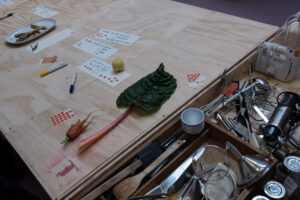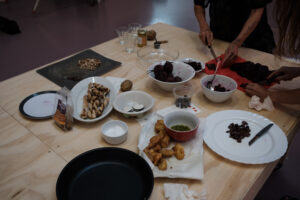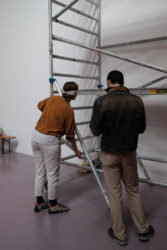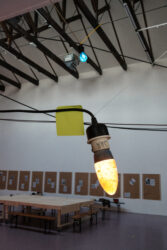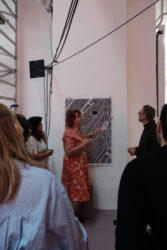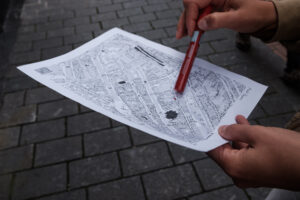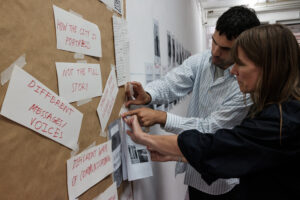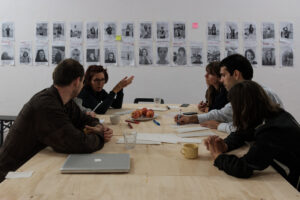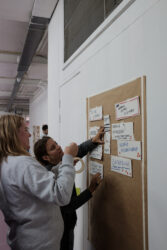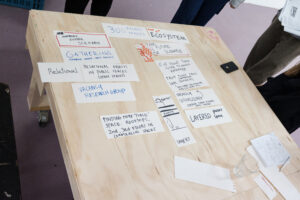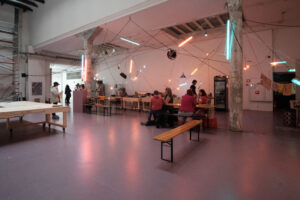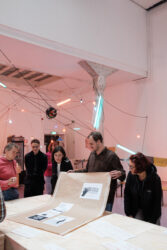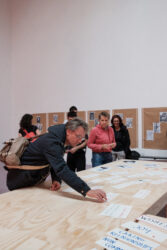The Active Space Camp was a 48-hour workshop with the intention of involving participants in ways that optimizes the chance for new ideas, networks, and initiatives to emerge. The artist-run space W139 in Amsterdam was the base camp for common meals, collaborations, discussions, and game-based explorations of the surrounding neighborhood.
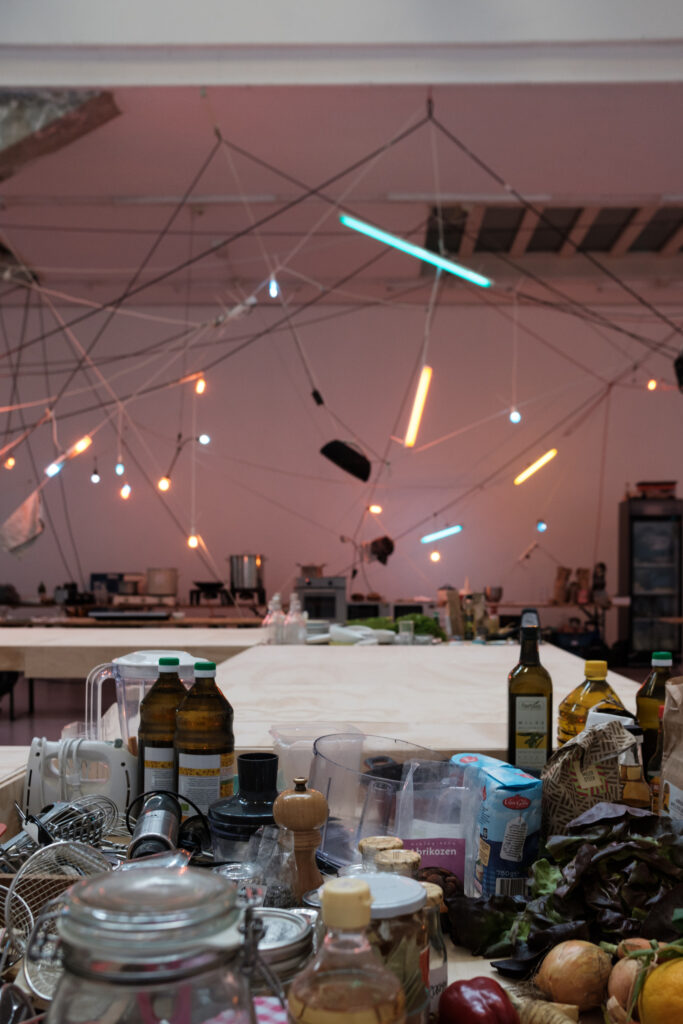
No City Without Art
The backdrop of the Active Space Camp was ‘No City Without Art’, a campaign by Platform BK and Kunstenbond to promote affordable living and working space for artists in Dutch cities. We wrote a manifesto, held many local conversations with artists and policy-makers (such as the ‘Elfstedentocht’), and published a comprehensive research report – comparing the studio and housing situation for creatives in six major cities throughout The Netherlands. The main goal for the Active Space Camp was to activate the insights built up during ‘No City Without Art’ from a bottom-up perspective, through the use of imagination and bodily exploration of the urban surroundings, and to create new scenarios for the present and future of the city together.
Exploring Bodily Space (Day 1)
On the first day of the workshop we, the participants, were greeted in the space of W139. Rather than doing a traditional round of introducing everyone in the room, all the participants were asked to send in a photo of themselves, which was then taped to the wall alongside their names. This way we were reminded of each other’s names and faces every time we entered the building. The core group of participants consisted of 16 people, including artists and cultural workers, neighborhood dwellers, researchers, and activists. The workshop facilitators were Jens Brandt, who led the workshop, Sepp Eckenhaussen and Koen Bartijn who initiated the event and supported Jens, Jeroen de Smalen who documented the weekend, as well as Bert Jacobs and Marcel van den Berg who provided us with amazing food.
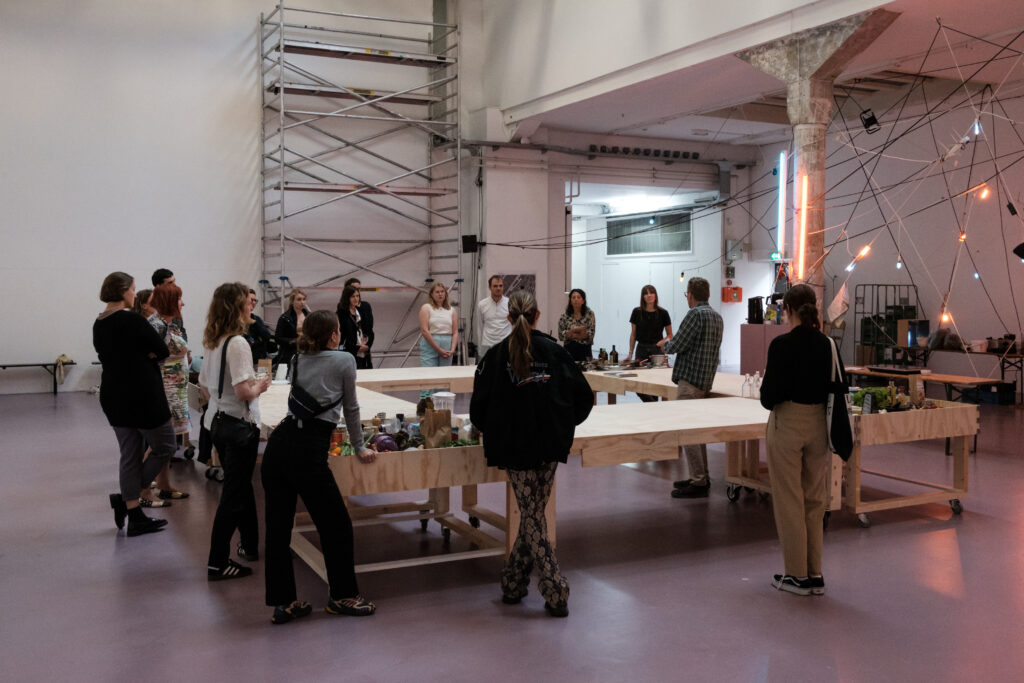
As a key concept of this camp, we were encouraged to consider the topic of space, in a physical meaning, but also in the bodily, social, and societal sense. Space is imbued with political, personal, social, and other meanings that we each experience as we enter and act in it. The big question becomes how we as urban dwellers can understand the spaces we operate in, and how we could work to see our surroundings with a new sense of curiosity. It just so happens that W139 is in one of Amsterdam’s more contested areas. With its location in the red-light district, the workshop would also come to center on how this particular area is home to a vast array of subject matters.
To kick off the weekend, we all practiced a sensory approach that would be repeated during the camp. We gathered around a big table covered with a variety of fresh vegetables and fruits. We were encouraged to touch, smell and taste whatever we liked, and to each pick an ingredient that somehow caught our interest. We all had our photos taken making a gesture or expression along with our chosen food, and the pictures were added to the name wall.
Following this exercise, we were asked to come up with an idea for a recipe that could be made with our ingredients and write them on a piece of paper. Everyone voted for their favorites by putting a red sticker on the recipe of their choosing. Based on the outcomes, we started cooking what seemed to be the most tempting choices as side dishes to the dinner prepared by Bert and Marcel. We cooked together, ate together, and enjoyed the rest of the evening in a relaxed atmosphere. This first day was important for all of us to get comfortable and ready for the more intense conversation that lay ahead.
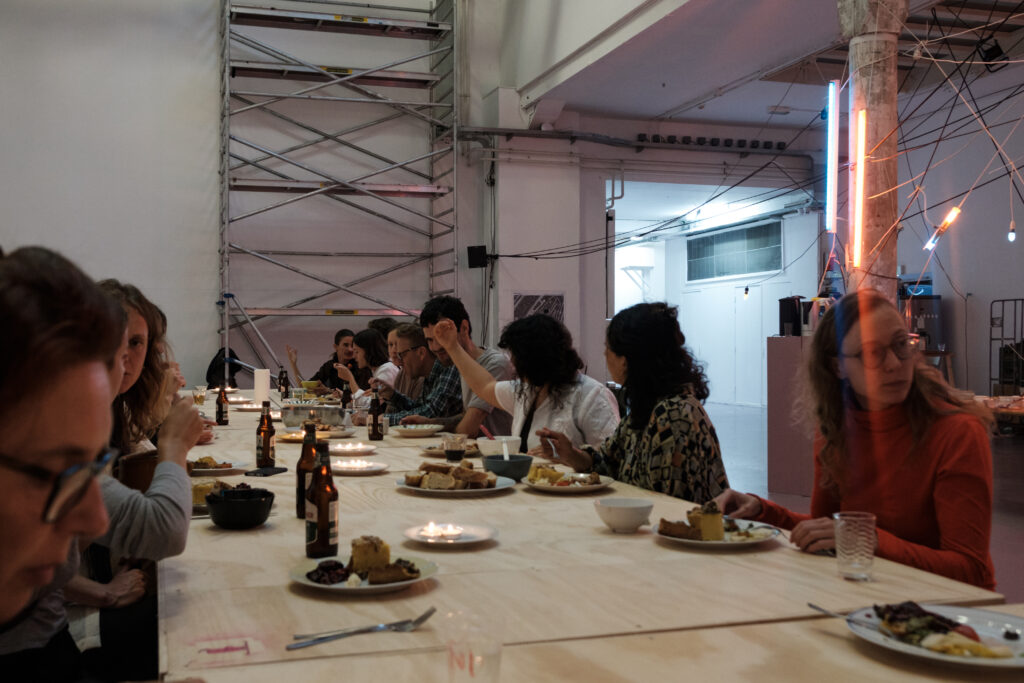
Interacting in Social Space (Day 2)
The second day began with a blindfold exercise to practice the art of seeing without seeing and feeling without knowing. In pairs of two, where one is blindfolded and the other not, we guided each other around the room. While exploring, the person wearing the blindfold interacted with furniture, walls, and other objects. They were asked to describe these objects based on the feeling and smell. The seeing person would then put a sticker on the said object, green for good and pink for bad. Quite quickly the entire room was covered in green and pink. Even such mundane things as pipes and planks were granted a colored sticker. It was, for instance, interesting to see that a simple screw received a lot of positive judgments. The exercise taught us to trust our senses in how we experience objects in space and to appreciate the everyday materials that surround us. Positive meanings such as ‘earthy’ and ‘joyous’ were assigned to food and electrical devices, while ‘unsafe’ and ‘cold’ were assigned to sharp table corners and metals.
With this openness of the senses still activated, we then went out of the W139 to walk around the neighborhood with a map in hand. We would mark down any spot we came by that interested us, where we felt that ‘something’ could happen, and eventually pick one spot to present for the group. When choosing a location, we were, as a continuum of the blindfold exercise, asked to consider the sensory experience of the location. Not just how the site looks, but also the feelings it awoke in us. We each took a selfie at the location that we would use to present for the others. When presenting our location there were commonalities in what people found desirable in their urban surroundings. Like what we did with the recipes from the day before, we were told to vote for the locations that appealed to us. By doing these voting exercises we kept the sense of appreciation and actively reflected on why and how space can inspire emotion and ideas.
We then headed out again, but this time walking in groups of five. We re-visited the locations chosen by each person in the group, and collectively picked a word to describe the feeling it left us with. ‘Shelter’ and ‘peacefulness’ exemplify some of the things that people found appealing, but also ‘play’, ‘timeline’, and ‘transitions’. We then took a photograph of the word we agreed upon at each location.
Truly these pictures show the personality we assign to space. Whether it is truly there or simply a result of our interpretation of it matters little, as it emphasizes the affective nature of the city as a place with a multitude of emotional qualities. For instance, going back to these spaces just an hour after the first visit, it was striking how some had already changed, showing the ebb and the flow of the city as a constantly transforming space around us. Places that were empty and quiet in the morning, became hectic and congested in the afternoon. The changing state of the city inspired discussions on temporality and belonging. Who has the agency to change the city? And how does rapid change influence social groups in different ways?
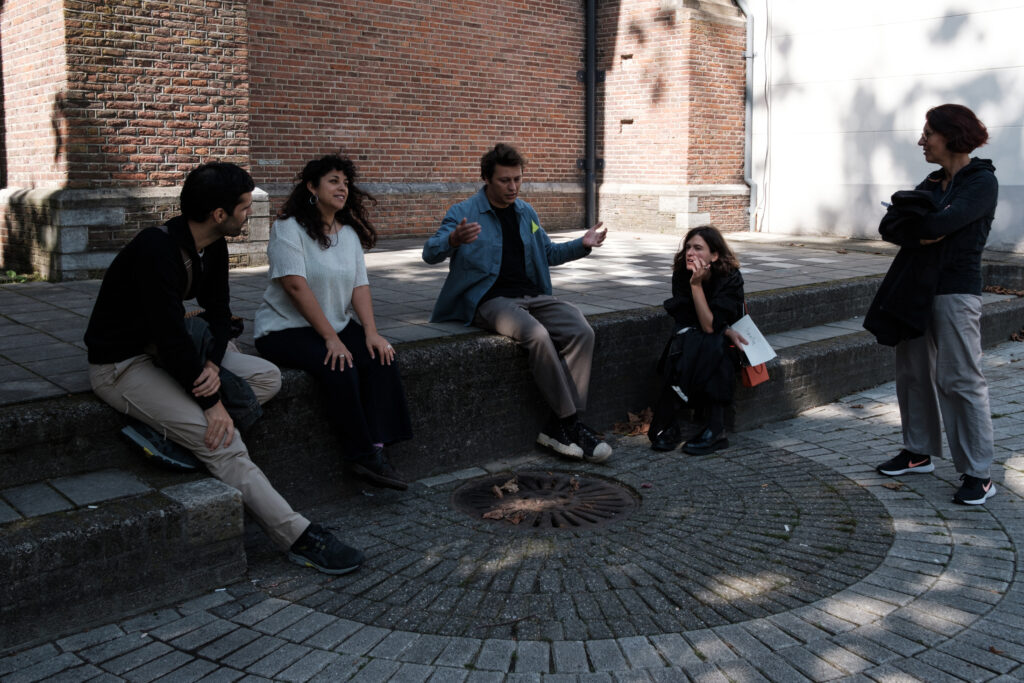
After now having gotten better known with the area, we got back together in W139 and started a discussion on how we can shape, influence, or activate the space in the city around us. In this discussion, we held focus on the why’s and the what’s, rather than how to bring about actual change. A consistent red thread running through this weekend’s activities was, as mentioned, the notion of affective space. Space is neither neutral nor static, but something we as people experience with subjective feelings. With this backdrop, we split into two sub-groups where we discussed our personal experience of this neighborhood. Some knew the area well, having lived there, while others offered an outsider’s perspective. What quickly became apparent was the contested nature of such a highly urbanized area. Some of the positive notions that were brought up included the spontaneity of the neighborhood, the quality encounters people experience, and the stimulative experience of being there. But perhaps more prominent were the negative association with the area, such as ‘over-tourism’, ‘gentrification’, ‘congestion’. A word that came up was ‘Nutella city’, an image of a space filled with sweet and enticing content but lacking actual nutrition. We also discussed the criminality tied to the area regarding the businesses that are allowed to operate. A general consensus seemed to lean towards more local-driven initiatives, which allows for the people living in the neighborhood to impact their surroundings. The groups also agreed upon the need for non-transactional spaces where social gatherings can take place outside the pressure of commerce. Such spaces represent a sort of peacefulness in that no one is excluded based on income. Furthermore, they allow for connection and exchange between people in a matter that goes beyond just monetary transactions.
It was also noticed in this context that the W139 is one of few functioning, non-transactional, public spaces in the city center of Amsterdam. The fact that we could do this program here shows the importance of space for art, as an integral component of public space, and for the livability of the city.
On the evening of our second day, local residents, urbanists, and artists were invited to join us in our discussion. This was very helpful for us to see the nuance of differences experienced by residents. The story of the neighborhood is not a single story but a multifold of realities, and so we must also include these different voices in our discussions. Many of the topics from the previous round returned, either with the same support or not. As an example of this, the term ‘balanced’ was initially praised as something desirable in urban space, but in later discussions, it was criticized for being a weaponized terminology to target marginalized groups who are often seen as disruptive to the desired balance.
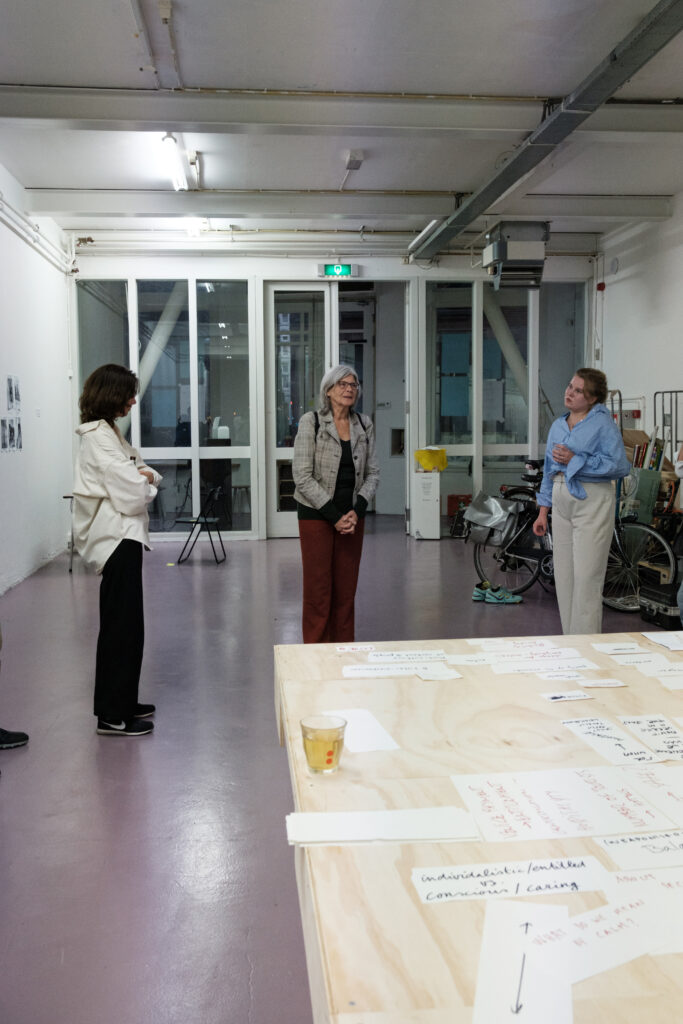
It was also discussed how the area previously served as a creative cluster for Dutch artists but now seems to have a much lesser artistic presence. Instead, a commercial focus has overtaken and replaced much of what was previously there. Yet, we were warned not to reduce the situation to a one-sided one. Places like the W139 still exist, and so do many other cultural facilities in the area. It must not be forgotten that what represents chaos and disturbance to some, might also inspire others. What we achieved on the second day of the workshop was a tentative agenda for action. Although there were differences in opinion and outlook, we managed to find certain commonalities that everyone could agree upon. With this as our inspiration, we could move into the third day of the workshop.
Activating Societal Space (Day 3)
For the last day of the workshop, we started with a discussion in the plenum on how we as citizens can have a transformative effect on the city. How do we take abstract ideas and concepts use them in a practical, action-oriented manner? Something that became quite apparent is that action requires knowledge. Without sufficient information on a problem, how can we possibly seek to remedy it? We, therefore, divided into the same sub-groups as the previous day and began a session of research.
Activist Anti-Advertisement
One group started with a focus on the misconceptions and simplifications in how the neighborhood is represented. Often Amsterdam is conceived as a party capital where people come to enjoy hazy evenings under neon signs. This is part of what the city has to offer, but certainly not the full experience. Particularly the surroundings of the red-light district are heavily influenced by a party culture that causes quite the annoyance for local residents. The municipality seems to be at a crossroad in this regard, seeing as they on one side do not want to disrupt the economy of this neighborhood, but on the other hand, they can’t deny that something must be done to, in city government lingo, ‘bring the situation back under control’. For this brief workshop, it was settled to address the issue with humor and use the power of the visual image. Thus, the group came up with the idea of a bottom-up campaign intending to poke fun at the warning signs that the municipality, with futility, have used to address unwanted behavior in the area. The idea is to build an anti-advertisement workshop where more such posters can be designed. Furthermore, a workshop like this would represent a creative space of non-transactional social gathering, something that was also desired among the participants.
Vacancy Research Group
The other group ventured into the topic of vacancy. According to the research made, there are over 200 vacant properties in the very center of Amsterdam. Many of these are owned as a means of investment, or they are previous commercial spaces that have been shut down. Despite being a prominent feature of the district, and a problem well-known for a long time, there is no comprehensive mapping of these vacant spaces. Thus, again fostering the power of the visual image (in this case of mapping), the group proposes a vacancy research project as a means to address the problem. The research project would function as both a way to gather more information and formulate solutions.
What Comes Next?
During the afternoon of the third day, the space of W139 opened its doors to any visitors and guests who were interested in the topic of the workshop. We presented our preliminary ideas to the visitors and welcomed their critique. Everyone that was present was encouraged to share their views and stories. We mainly discussed how the vacancy research project could be done, as well as new ideas that inspired debate. Once again, the ideas were evaluated using the red sticker-voting method.
The primary ideas brought forth during this weekend reveal two parallel desires between the groups: that of non-commercial spaces of production and that of sensory, experimental communication. In regard to the first of these desires, both the activist anti-advertisement group and the vacancy research group wanted to create space, both in the physical and societal sense, where people can come as they please without paying for entrance and contribute to the production of knowledge and ideas about the neighborhood. In the case of the latter, both groups sought out the use of visual, and even auditive, instruments to communicate their ideas. To exemplify this the concept of creative visual mapping of the area was popular, and some participants also played with the idea of using urban soundscapes to express the values we were all looking for. It is not far-fetched to imagine that the two desires will in the end combine into one project: creating anti-advertisements to share research results of the vacancy research and promote non-commercial space in the Red Light District.
Finally, the question comes of what we actually achieved during this intensive workshop. It goes without saying that change happens gradually and must start with bite-sized efforts. What the Active Space Camp provided was a place to initiate important discussions on how urban citizens can come together in solidarity. We learned to keep our senses alert to our surroundings, and to not forget the appreciation of the pre-discursive, affective characteristics that shape the way we experience the city and should inform the way we shape it. As a group, we created an environment where we could think outside the box and see how we ourselves can be of influence in the city. The engagement for continuation is apparent in the mailing list which was made. Anyone who is prompted to follow up on the ideas from the workshop could (and still can) write down their e-mail, and through this list, it is possible to extend the workshop onwards.
Mathilde is a student of the rMA Urban Studies at the University of Amsterdam and works as an intern at Platform BK.
